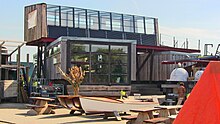De Ceuvel
De Ceuvel is a project area on the site of a former shipyard in Amsterdam-Noord . On the former marine IJ branching Van Hasselt Channel were on with industrial contaminated sites placed contaminated soil, houseboats on pedestals in which since 2014 have been accommodated offices, studios and workshops for companies and initiatives. These belong to the cultural and creative industries as well as environmental technology with a focus on sustainability . At the same time, phytoremediation is used to reduce pollutants in the polluted soils at the site itself.
history
In 1919, a shipyard was built on the shore near the Fokker works. Also due to the ice-free waters at the shipyard in winter, it flourished from the 1920s. During the Second World War , it was only slightly damaged by bombing the nearby Fokker factory. In the 1950s, economically stricken and in poor condition, it was bought by Louis Marie Pieterson. He invested in a new engine room and a new pier and also built his private house on the shipyard site. In the early 1970s, the Ceuvel company bought the facility, which was expanded and expanded several times in the following years. Nevertheless, the shipyard was closed in 2000. It was too small compared to the competition and also threatened by plans to build a bridge that would have restricted access for ships. In 2002 the shipyard building was demolished.
In 2012, a team of architects won a ten-year lease for their concept of a sustainable De Ceuvel office park. From 2013 houseboats were delivered, lifted out of the water and positioned on land. The site was opened in 2014.
investment
De Ceuvel is a 1250 m² site on the Van Hasselt Canal . 15 former houseboats were placed on it, each standing on plinths 90 cm above the contaminated soil. The houseboat concept takes into account the ten-year contract period for the property by the city of Amsterdam and is intended to make it easier for the project to move later. Due to the soil contamination, it was not possible to dig deeper than 50 cm for foundations or supply lines, which is why they run in the surface area.
The boats were converted into offices, studios and workrooms. The architects, landscape planners and sustainability experts opted for inexpensive solutions to deal with the particular situation: solar heating, air conditioning or composting toilets were used, as well as the filtering and use of rainwater and plant-based wastewater treatment. According to the operator, the water consumption is 75% lower than that of a conventional commercial space of this size.
Plants are also used to detoxify the polluted underground. Targeted as hyperaccumulators , they remove toxic metals from the soil. To do this, however, they have to be harvested, disposed of and re-cultivated once a year.
The individual houseboats are connected to one another by a curved, planked wooden walkway. In the center of the area there is a café with outdoor dining and a bed & breakfast .
The use of the site and the whereabouts of the project after ten years of interim use are still open.
Web links
- wethecity.nl with videos on the construction of the facility
- official website (English and Dutch)
Coordinates: 52 ° 23 ′ 35.9 " N , 4 ° 54 ′ 37.8" E
Individual evidence
- ↑ a b General Information. In: De Ceuvel. Retrieved June 16, 2019 (American English).
- ↑ a b Christopher F. Schuetze: Building a Community on Polluted Land . In: The New York Times . November 19, 2014, ISSN 0362-4331 (English, nytimes.com [accessed June 20, 2019]).
- ↑ a b c A green oasis on the Amsterdam canals | DW | August 18, 2015. In: dw.com. Deutsche Welle, accessed June 20, 2019 .
- ↑ a b Gunda Schwantje: Alternative town planning: Linking the elements . In: The daily newspaper: taz . August 23, 2015, ISSN 0931-9085 ( taz.de [accessed June 23, 2019]).
- ↑ PROJECT | DE CEUVEL - WE THE CITY. Retrieved June 20, 2019 .
- ↑ De Ceuvel. Retrieved June 23, 2019 .




